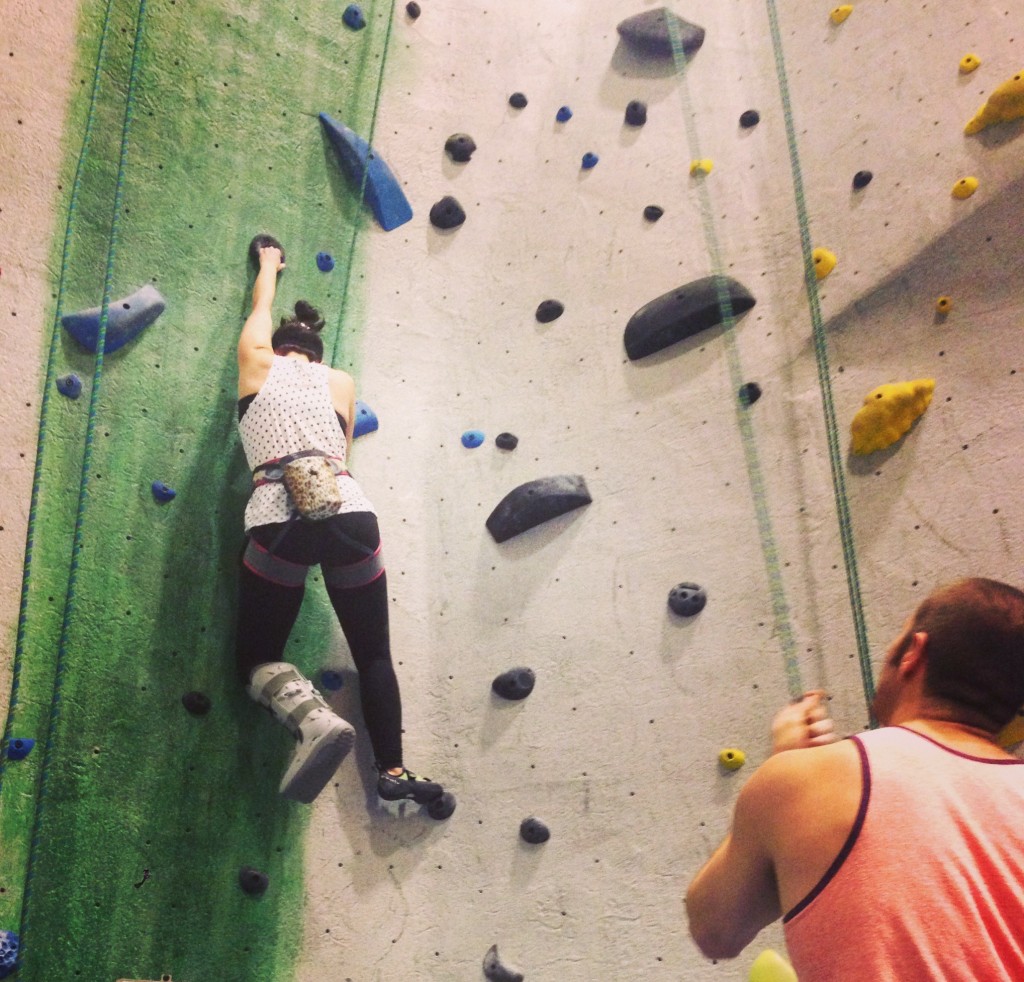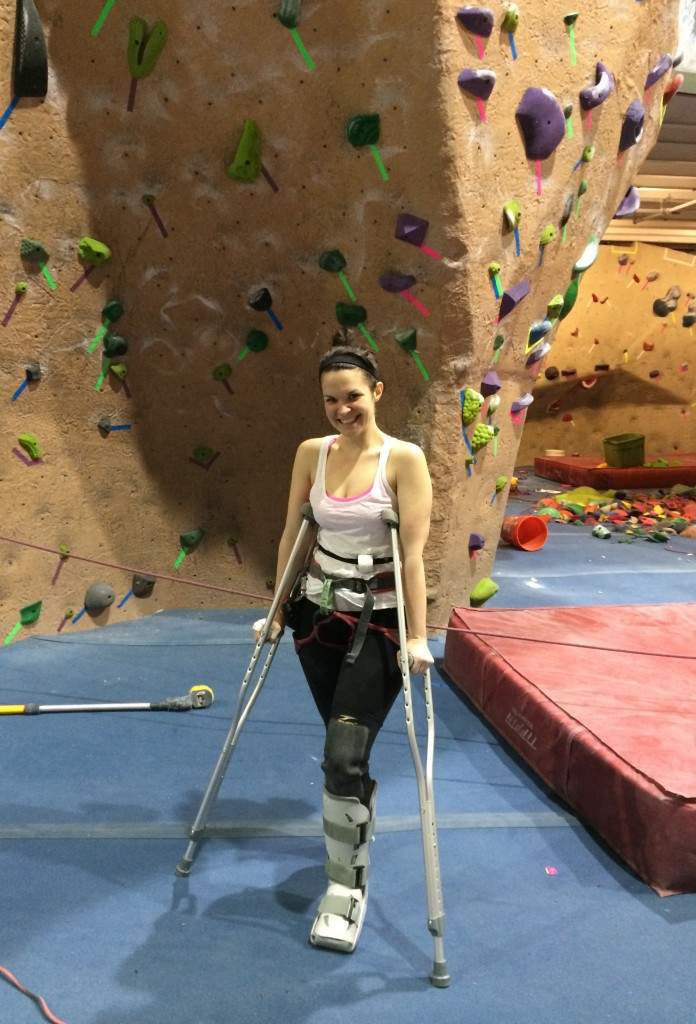How To Deal When You Are On The Injured List: The worst part about being injured is not the pain, but the mental game. I have been at times overwhelming, in tears, thinking about the setbacks, how long it will take me to get back to where I was, and how much I just plain miss climbing, and the climbing community. I was just starting to get super psyched on bouldering outside. That was new for me and it felt satisfying.
Then I made one dumb mistake doing something I’ve done a hundred times. I just needed to jump 2 or 3 inches further back and I would have been fine. Instead, as I was jumping off this problem, my left foot didn’t land completely on the crush pad, and it hit part of the boulder. In a second, my ankle was fractured, and my life was very different.

Learning how to climb with one foot is kind of like learning to climb for the first time.
How To Deal When You Are On The Injured List
I’ve never had an injury before. As you may recall about me, I’m the “newb”. I have never really been athletic in my whole life, very much the city gal, and certainly have never injured myself (unless you count, like, breaking a nail as an injury). So, having no idea what I was in for, for the first week, I was surprisingly positive. I watched Courtney Sanders’ video about training with her ankle injury a bunch of times, and read up about training while injured online.
There are a number of inspiring stories like this one, or this one, or great tips, for example from pro climber Steph Davis on how to train when you have to stay off one leg. And from Evening Sends on how to not be annoying about being injured. Having armed myself with knowledge, I was feeling upbeat, and thinking to myself that this was going to be a great opportunity to focus on other aspects of fitness and that I would get back to climbing, barely missing a beat. Well, I’m here to admit that isn’t exactly how it’s been going.

Here’s me on Ship’s Prow boulder in Lincoln Woods, RI just a moment before the accident.
A big part of my mental game has been about fighting off the (irrational) guilt I feel for taking what seems like a substantial break from climbing. With the information that is currently available online about training while injured, you could easily feel like if you aren’t out there campusing on a rigged-up pulley system, and climbing 5.11 with one foot by day 3, well then, you probably don’t really like climbing anyway. Here’s the thing: I want to play it safe. I know, I know, playing it safe is like totally not cool, and not hardcore.
But, I also was told that I need to stay off it for a month, stay in the cast and on crutches, or risk needing surgery. So climbing is going to have to take a backseat for a few weeks, and healing is going to be priority number one. I keep thinking to myself that taking a few weeks off now could save me from having to take months off later. And believe me, a month has felt like a year, so I’m all set.
Just like everything that happens in life, it has something to teach us. If we don’t look at life as a process of constant learning, we will be at the very least disappointed. Here are the things that I have taken away from this process so far, and hopefully they can be helpful to you if you ever find yourself in a similar position:
1) Don’t Beat Yourself Up
Period. End of story. Mistakes happen, accidents happen, that’s life. You are in the situation you are in now, you just need to move forward. Do not dwell on the past, or dwell on worries about the future either, because that makes you feel worse, leads to being stuck, and does not lead you toward committed action. This was hardest in the first week or two, but then it got easier. Keep coming back to this first step every day.

And my “boot twin” Ashley, trying to have a sense of humor about it, which is also key.
2) Let Your Body (And The Medical Professionals) Be Your Guide
We have to blend both medical wisdom and our own knowledge of our bodies, which is a very fine line to walk (or hobble, in my case). Your doctor may tell you no climbing, not to do certain exercises, how much to stay off your injury, etc. Whether or not a person chooses to follow that information is up to them. And that is an extremely personal decision that one shouldn’t be judged for. It is important to have a doctor who understands climbing to some extent, and one who has experience working with athletes.
A doctor more familiar with climbing might be able to give you more specific instructions on how slow to take it, versus a doctor who doesn’t might, for example, tell you not to climb at all, without knowing what that means. Listening very closely to your body will help you as well. For the first 7-10 days I was injured I felt exhausted.
I’m not sure if it was physical (getting around on crutches all day is more of a workout than I had realized) or mental (having to think about how to do every little thing) or a combination of both, but when I tried working out in the first week I felt like I had nothing to give. I was beaten. It was hard to focus. It took about 3 weeks for me to start feeling more like myself again. Needless to say, I had to keep going back to tip #1, a lot.
3) Maintain Your Motivation By Setting New Goals
As Courtney Sanders says in her video, you have to find new goals to work on and new ways to “stay psyched”. It’s a matter of accepting that your goal right now can’t be climbing a certain project, but that it can be, say working on pull-ups or finger strength. As climbers (and I think just human beings in general), we tend to be driven by immediate goals and rewards, and it can be hard to focus long-term. Staying motivated with something that is weeks or months away is difficult, so try to keep it tangible, and achievable in the short term.
The other cool thing is, that if you choose to climb through your injury, you can adjust your goals and expectations and just appreciate being able to climb at all. Even if it’s 5.6, it feels amazing. Taking this time to let go of the pressure you might place on yourself, and just connect with the things you loved when you very first started climbing is something to be grateful for.

Total Top Rope Tough Girl (note the knee pad, tape, GriGri, all I need is a helmet)
4) In Strength Training, Do Not Put Yourself Out Of Balance
Because in general when we are injured, there is one side of the body you can’t really work, you don’t want to overtrain the muscle on the opposite side, otherwise, when you get back to climbing you will find yourself imbalanced. In my case, I don’t want to be doing a bunch of exercises on my right leg while my left leg is just hanging out. As a general rule, do the exercise on both sides, and if you can’t do it on one, hold off on doing it until you can do it on the other.
On a separate note, it’s killing me not to do squats and lunges and deadlifts, as a woman over 30 with pear-shaped genetics, I’m always fending off the “pancake butt”, so I’ve REALLY had to keep reverting to step #1 on that issue. Remember that our muscles have memory, and you will quickly re-adapt even after a lengthy break.
And, most people that I’ve spoken to say that they felt they came back even stronger after an injury (once you get past the first couple of sessions of feeling like a complete beginner again). For a complete overview of all the workouts I have been doing, click here.
5) Just Like We Keep The Body In Balance, It’s Important To Keep Life In Balance Too
While yes, climbing is something that is likely of maximum importance in your life, I think we also need to learn to adapt and be flexible, because things can happen in life where all of a sudden everything changes, and we can lose things that we love. We don’t like to think that, but it’s true. It’s possible that something can happen where you either can’t climb anymore, or the way in which you do it is with limitations that you didn’t previously have. I think it’s important that we have other things in life that matter to us, to balance us out.
For example, having other interests, hobbies, and passions, nurturing your relationships with friends and family, and having other ways of dealing with stress. If you don’t do these things, I think you actually leave yourself quite vulnerable. Being injured made me realize how much of my life I do spend climbing, and how I have a tendency to neglect other things that are important to me, and I want to try and do a better job of attending to those, even as I get back into climbing with more regularity.
If you choose to keep climbing over a lifetime, chances are good that you’ll have an injury of some sort in the future. Of course, we do what we can to minimize this and at the same time, we accept that as part of the risk of doing something we love. So I hope that these tips are helpful to you if you ever need them.
-Climb (and hobble) On!
Missy
Do you have tips for dealing with an injury? Leave them in the comments, we’d love to hear from you! Click here to view Missy’s full list of workouts and routines.






